| |
Pit
Bikes and cool sh**
=:-o
OfFicIAl pIT biKe heAdQuArTeRs o-:= |
ΔMouseOverLogoΔ |
| Pit Bikes in various forms have been around for years. A pit bike started out to be any small bike used by car/motorcycle racer to navigate the “Pits” (the area designated for parking and setting up prior to an event). Today, pit bikes have evolved to look like mini versions of factory MX motorcycles, and have a full race series. |
 |
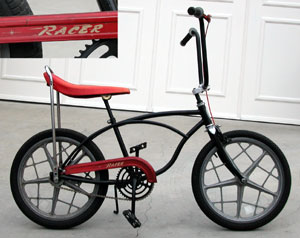 |
The first pit bikes were simply bicycles. Schwinn StingRays (first produced in 1963) were quite popular because they were small wheeled, but stretched to fit even a full-sized adult (sound familiar?). StingRays are credited with starting the BMX craze. (Note: this slick StingRay has the classic ‘banana’ seat, ‘ape-hanger’ handle bars, ‘Racer’ chainguard, and rare aluminum ‘MotoMag®’ wheels.) | |||
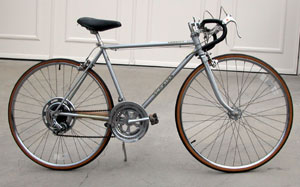 |
Of course, lightweight “10-speeds” (as they were called because of their gearing) were used as pit bikes by a few racers who wanted something that looked more like a race bicycle. The extra gears gave them more speed and greater range--thus more usability. (The photo shows a NOS 1976 made-in-Chicago Schwinn Varsity.) | |||
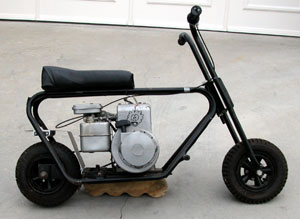 |
The classic 1950/1960's “mini-bike” was also a great way to navigate the pits. They typically had a 3HP Briggs & Stratton engine, pull starter, no suspension, and a brake that rubs on the rear tire to stop it. (Note: this particular one has the larger 5HP B&S--it’s scary fast...especially, with such a whimpy brake.) | |||
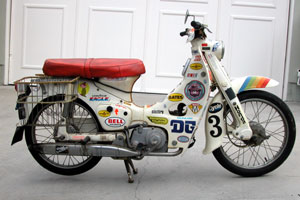 |
The Honda Super Cub 50 came to the USA in the mid-1960s. This simple 50cc motorcycle started the entire Japanese motorcycle invasion. Millions upon millions were produced. The 4-stroke, horizontal engine layout is the basis for most pit bike engines of today. (The bike in the photo was used as a pit bike by a racer of a vintage Lotus Elan.) | |||
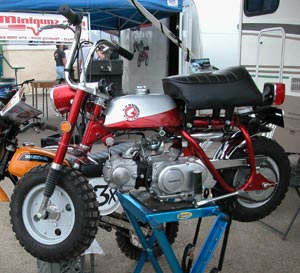 |
Honda Z50 Mini Trail started it all. It was the first small Honda motorcycle produced to go off-road. Because their small size allowed them to fit in the corner of just about any trailer, Z50s saw a lot of duty as pit bikes. Introduced to North America in 1968, the bike saw numerous updates during the 30 years it was produced. For instance, in 1970 rear shocks were added. In the rest of the world they are called “Monkey Bikes.” Early Z50s, like the one in this photo (w/o rear shocks), are highly-collectible and when restored can sell for thousands of dollars. |
|
||
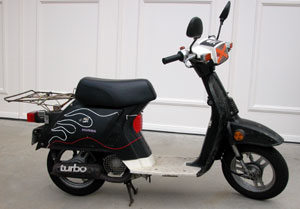 |
During the 1980s, the Honda NQ50 Spree was the standard in pit pikes for car racers. The Spree’s 2-stroke 50cc engine had an electric starter, and made for a lightweight and rather zippy scooter. Sprees fell out of favor just like most 2-strokes...due to emissions, smell, and noise. (Sprees, and the similar Elite, still have quite a following on eBay and the web--the one in the photo has an extra large rack for hauling stuff around in the pits.) | |||
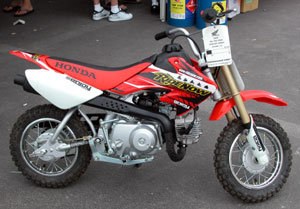 |
The Honda XR-50F/CRF-50F mini-moto was the bike that most every motorcrosser started out riding. These 4-stroke 50cc engine dirt bikes (along with their many counterparts from Suzuki, Yamaha, Kawasaki, etc.) are the inspirational starting point for the pit bike craze. | |||
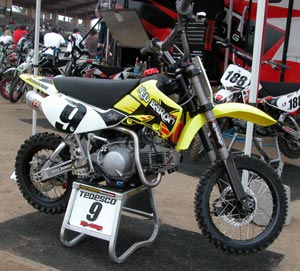 |
The PIT BIKES of today retain the 10" or 12" wheels and basic 4-stroke motor of a minimoto; but in order to perform with a full-sized adult aboard, pit bikes are engineered to have a longer wheelbase, taller/wider handlebars, way more suspension, a punched out bore to 110cc, and many other tweaks. There is something about a pit bike’s toss-able size that make them hard to take too seriously...and a big reason why pit bikes are such a frickin’ blast to ride. |
FAQ
SHEET GOES HERE: |
|
Our
mission is to represent the best of what the Pit Bike community has to
offer. |
| Copyright
©Caroselli. All rights reserved. |